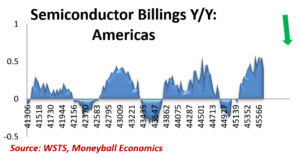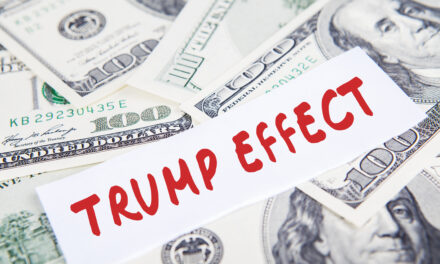Earlier this week, I shared that I was expecting the Fed to issue a “surprise” rate cut in June.
Today I’m following up with a deeper explanation of exactly why that’s going to happen — starting with the #1 most important economic indicator (and what it’s now telling us about 2025).
Let’s get to it:
Video transcript:
Hello fellow Moneyball economists. I’m Andrew Zatlin, and today is the day we take some economic data and transform it into investing ideas…
The topic today is interest rates — or more particularly when are interest rates going to be cut.
That’s the big question. Nobody seems to know the answer, not even the Federal Reserve Bank themselves. In fact, they recently came out and said, “we’re not cutting rates this time. When are we going to cut rates? We don’t know. How often are we going to cut rates? Don’t know how deep. Sorry.” No answer.
As they said, there’s just too much uncertainty right now, monetary policy has been hijacked by fiscal policy, meaning Donald Trump’s tariffs. The Fed is saying “we don’t have enough insight into what’s really going on with tariffs. Are they really inflationary? Maybe China’s going to absorb all this cost we don’t know.”
What we do know is traditionally tariffs boost inflation and slow the economy, and that is a big problem for the Federal Reserve when your only tool is interest rates.
See, at the end of the day, the concern right now is that we are entering a stagflationary environment.
As a reminder, stagflation is this economic condition where interest rates are running hot and the economy is not. And that creates basically a “damned if you do, damned if you don’t” situation for the Fed.
They could try to boost the economy, but you cut rates to do that and all you’ve done is you’ve offset it with higher inflation. Or you could address the inflation part of the equation by raising rates. Well, all you’ve done now is slow down the economy. Their hands are tied, and the one thing that’s going to untie their hands is more certainty.
And so every day we get an economic data point coming out.
It may say, “oh, inflation’s not that bad.” Or it might say, “oh, the economy’s not that bad,” and the markets respond one way or the other.
We’re going to get more certainty in a couple of weeks when earning season kicks off because that’s when companies themselves come out and say, this is what’s going on in my business. This is the demand side of the equation today and going forward, and that pretty much informs us, but we don’t have to wait.
See, I’ve been informing my clients recently that the Fed should be in no hurry to cut rates yet, but I do see a situation as certain, maybe as early as June when they might come out with a stealth rate cut.
Now, why June? Well, that would surprise the markets. The markets are now thinking September, you come out in June with a rate cut, everyone’s going to be surprised.
I want to share with you one of the data sets that I’m using that tells me the Fed isn’t going to cut rates now, but they might reconsider at their June meeting. It all comes down to semiconductor data.
Oh, I’ve talked about it before and it’s worth repeating:
Semiconductors today are the lifeblood of the 21st century digital economy.
You track semiconductors and you are essentially tracking a proxy for the macro economy.
In the 20th century, the industrial era, you would track steel, you would track oil because when the economy is expanding, you’re building new factories, you use steel, the economy is expanding, it consumes more electricity and energy. That’s oil. But today, whatever you’re buying in an expanding economy is going to get reflected in consumption of semiconductor chips.
Semiconductor chips are in everything you’re buying, or if they aren’t, they’re in the thing that made the thing you’re buying or buying less of.
So let’s talk about what the semiconductor data is telling us…
If you look at this headline number chart, what you’re going to see is things look great globally:

Economy seems just fine, but you know us, we like to go below the surface because there’s a lot more nuggets of information when we do a deep dive. And in fact, that’s what you see. There are four major regions out there that we’re tracking.
When we look at semiconductor data, there’s the us, there’s China, there’s Europe, and there’s Japan, and each one is sending a very different economic signal.
Let’s start with the us. The US looks very, very perky. They look like we’ve got continuing growth today and going forward, no reason to cut rates, maybe even reason to raise rates:

Well, it’s a totally different view if you’re in China, while it looks like they’re growing more recently, they’re starting to collapse:

Europe, there is no growth, there hasn’t been growth in practically forever:

Japan, well, suddenly they’re getting perky too:

So let’s take the semiconductor growth data and let’s line it up with what we know about the macro economies for these regions.
Let’s start again with Japan. Work our way backwards to the US.
Japan semiconductor data has been signaling for quite some time that things are getting perkier, and in fact, that’s exactly what’s happening in the Japanese economy. They’re starting to see some wage growth.
The Bank of Japan is talking about maybe they should be raising interest rates because after all, if things are perking up and you’re getting inflation, you want to be careful there, not let things get out of control.
But this is the first time in a long time that we’ve seen this.
In essence, this would point to either a slightly stronger yen or a little bit maybe beyond that. Even right now it’s around one 50, maybe go down to one 40 strong yen. That would be interesting.
But the other side of the equation is Europe. They got nothing going on. They are an economy that is in a very steadily slowing decline. A lot of that’s because Germany offshore, a lot of their production, they moved a lot of auto production to China, for example.
At the end of the day, if the economy is this stagnant, and in fact it has been, the GDP for Europe has been basically below 1% year in, year out for a long time, excluding the covid years, Europe has to do some kind of stimulus, fiscal and monetary stimulus if they’re going to get out of the doldrums.
That’s what this data is telling us, and that’s what we’re starting to hear. Let’s cut rates dramatically. China similar. They’ve gone from boom to bust, and when they’re in that mode and it’s going down sharply rapidly, China’s going to do anything they can to stimulate the economy, fiscal and monetary.
And again, that is what we are starting to see is that motion.
Expect the yuan to go down, expect the euro to go down relative to the dollar, and that brings us to the dollar to the United States.
So if you look at this data, you would say everything’s boom times for the US. Why would we cut rates? And that’s where we want to be a little cautious…
A lot of the semiconductor growth is being turbocharged by what’s happening in AI because let’s face it, Nvidia and other chip companies are in the US. They’re doing gangbuster business and that’s boosting the semiconductor signal. Strip it out. You have growth. It’s just not so turbocharged, but you have growth.
However, this is through January now, we come to February, we come to March.
When the tariffs are kicking in, I think we’re going to see a sharp decline.
And I say that because also remember a lot of people were front-running tariffs. So we’ve got a situation where not only is this US signal overstated because of AI, it’s even overstated in the past few months because of some front running of tariffs.
I think we are going to go sort of the route that China’s been going. In fact, I would suggest that China’s collapse is related to maybe they’re leading us basically, and we’re about to see a similar collapse. We’re going to see that show up in the data, I believe starting in June.
So the Fed is suddenly going to see certainty.
The economy is going to be slowing down rapidly and we’re going to see a uniformity in that data.
And I believe that we’re going to see a slowdown as well in the impact of the tariff. So inflation’s going to come down a little bit as well. Put it all together. I think the fed’s going to cut rates in June.
That’s going to turbocharge the markets.
Gold is going to go up. There are a lot of ways to play it. You know how to do interest rate cuts.
You go long on technology, you go long construction, you go long gold, real estate, so many different places to go. I think it’s going to happen in June. And if I’m right, you’re going to see a race up in this stock market.
Folks we’re to win it. Let’s do this.
Zatlin out.

Andrew Zatlin
Editor, Superforecast Trader & Moneyball Economics





